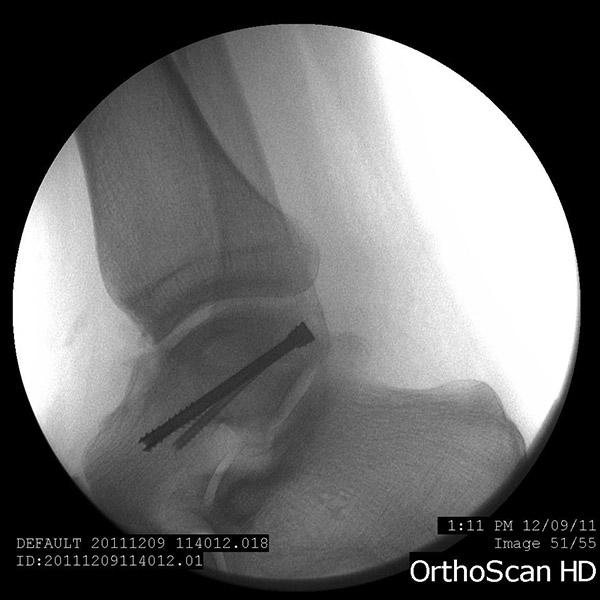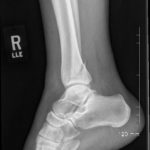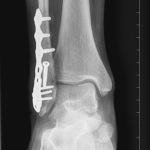Ankle Fracture: General Facts
An ankle fracture can range from a relatively minor twisting injury or due to high energy trauma. Those with high energy, such as in a motor vehicle crash or with high falls, oftentimes have a worse prognosis depending on associated injuries to the articular cartilage. Ankle fractures from sports such as basketball, soccer, or football, are considered lower energy injuries. The most important factors in having a good result are the alignment of the bones and any injuries to the articular cartilage associated with the trauma of the injury. More extensive injuries that include 2 or 3 malleoli (bimalleolar or trimalleorlar), dislocations, and syndesmosis tears have a greater chance of having articular cartilage injuries.
Office Appointments and Telemedicine with Dr. Carreira

You can also book an office appointment or a telemedicine visit by calling Dr. Carreira’s office at 404-355-0743. Book now.
The Role of Arthroscopy in Treating Ankle Fracture
In the February 2019 issue of Inside AANA eNewsletter, the Arthroscopy Association of North America (AANA) published an Introduction and Point about the role of arthroscopy in treating ankle fractures. The Introduction was written by Thomas F. Golden, M.D. and Casey Pyle, D.O., while the Point was written by Richard D. Ferkel, M.D.
As a member of the AANA, Dr. Dominic Carreira has shared links to these two pieces as he supports and agrees with the positions posted by the authors. (They are both in PDF format.)
Arthroscopy’s Role in Treating Ankle Fractures » (PDF)
Debate of Arthroscopy for Acute and Chronic Ankle Fractures – Pro » (PDF)
Because success following ankle fracture depends on treating the articular cartilage, arthroscopy contributes to better treatments of many of these injuries, especially when performed by a very experienced arthroscopist.
Patient-Focused Study: Use of Narcotics in Treatment
Summer 2018: At Peachtree Orthopedics, Dr. Carreira and his colleagues are currently undertaking two important studies of ankle fractures related to their outcomes.
The first study is a careful study of the use of narcotics. This topic is an important one given the national abuse epidemic. A new educational program which was started in July 2018 is being studied to compare patients’ use of narcotics.
Secondly, as part of a study led by the Multicenter Arthroscopy Study of the Ankle and Foot (MASTAF), those patients with ankle fractures who undergo arthroscopy to address injuries inside the joint may also be enrolled. The MASTAF research project is a multi-center trial of ankle arthroscopy. Dr. Carreira is a founding member of MASTAF.
All patients have the option of enrolling (or not) in these studies, and participation is truly optional.
Dr. Carreira is actively involved in developing the field of foot and ankle and contributing further to the treatments of broken ankles.
Video of an Ankle Fracture
The above video shows the fracture of an ankle caused by a skate boarding fall.
Treatment of an Ankle Fracture
If the shape and anatomy of the ankle is not accurately restored, the cartilage lining of the ankle is disturbed which may lead to arthritis.
For a broken ankle, the goal of treatment is to realign the bones in their normal position and hold them in place, typically using plates and screws. Proper alignment of the bones helps to prevent arthritis.
Surgery is performed with incisions on one or both sides of the ankle, and depending on the severity of the fracture, arthroscopy may be beneficial to assess and treat articular cartilage damage inside the joint. The arthroscopy typically adds just a few minutes to the procedure and does not prolong recovery. Through arthroscopy, the cartilage injury, which can lead to early arthritis and ankle pain, can be treated at the same time as the fractured ankle bones. A microfracture technique can be performed for deep cartilage lesions and loose bodies, or fragments of cartilage, may be removed.
Inpatient vs. Outpatient Surgical Treatment of Ankle Fractures
A recent study conducted by the Northwestern University Feinberg School of Medicine examined inpatient vs outpatient surgical treatment of ankle fractures. According to the report produced from the study, there were a number of medical benefits to the conducting outpatient surgery on a variety of ankle fractures.
Postoperative Recovery Following Ankle Fracture Surgery
- Following surgery, a bulky splint is applied to the ankle until the stitches or staples are removed at approximately two weeks.
- If the left ankle is broken, you can drive once you once you have stopped taking narcotics. For the right ankle, driving can be started at 4 to 6 weeks.
- No weight-bearing is permitted until 4 to 6 weeks.
- At 4 weeks, exercise activities are initiated in a swimming pool and on a bike. At 6 weeks, a gradual increase in activities is recommended.
Photos of Ankle Fracture
Before and After X-Rays Showing Ankle Fracture Repair
Talus (Ankle) Fracture Treated with Arthroscopic Assistance

The above photo shows a talus (ankle) fracture treated with arthroscopic assistance. Of note, the screw fixation is noted on the X-ray.
Ankle Fracture Physical Therapy Protocol
This protocol provides you with general guidelines for progression of rehabilitation according to specific time frames. Specific changes in the program may be made by the physician as appropriate for the individual patient. Adjustments are to be made especially based on patient age and functional baseline/demands/expectations.
Please fax initial assessment and subsequent progress notes directly to Fax #: 855-270-3558.
It can take up to a year to make a full recovery, and there may be intermittent pains and aches during that time. Swelling may be on-going for several months.
FOR PATIENTS
- Recovery at a glance:
- Compression stocking to be worn to control swelling along with ice/elevation once the incision has healed.
- Physical therapy to start at 2-3 weeks post operation.
- You may begin driving at 6-8 weeks if surgery on the right ankle. If surgery on the left ankle and driving an automatic, may drive once off narcotics and allowing for elevation. Test your ability to drive in a parking lot!
- At 12 weeks, begin gentle running/higher impact activities.
- Once you can come up and down on your toes (single heel rise) on the surgical side, or you can hop on the surgical foot (single leg hop), you may return to sports and all activities. This may take 6 months to a year.
FOR PHYSICAL THERAPISTS
Acronyms for Physical Therapy Guidance
- DF and PF: Dorsiflexion and Plantar Flexion – the commonly understood movement of the ankle, up and down.
- PROM: Passive Range of Motion
- DF stretches: Dorsiflexion stretches
- BAPS: Biomechanical Ankle Platform System – a balancing board used in physical therapy to improve balance, proprioception, and neuromuscular control in the ankle, knee, and hip.
- FWB: Full weight-bearing
- A/AA/PROM: Active, Active assist, and passive range of motion
- CKC THERABAND: Closed kinetic chain THERABAND – a way of strengthening
Detailed recovery/rehabilitation protocol:
Phase I: Weeks 1-3
Goals
- Safe non weight bearing crutches /walker/ knee-walker.
- Incision care-keep clean and dry. Shower boot or saran wrap with showers until closed. If concern of wound, please take a picture and refer patient back to our office.
- Edema control / swelling control.
- Maximize ankle motion.
Guidelines
- Maintain ankle motion with toe crunches; ankle alphabet; ankle pumps.
- Leg elevation.
- Safe use of crutches/knee-walker.
- Increase safe ADL (activities of daily living).
- Keep incision clean/dry.
- Sutures or staples removed at 14 – 21 days.
Phase II: Weeks 3-6
Goals
- FWB involved LE in walker boot to be determined by doctor to start between 4 – 8 weeks.
- 100% AROM in all planes in ankle DF and PF.
- Control edema.
- Minimize complications.
- Maintain optimal bone and soft tissue healing environment.
Guidelines
- Gait training level surfaces with proper tibia advancement, quads activation, symmetrical weight-bearing.
- Stationary bike.
- Grade 1-2 joint mobilizations ankle joints.
- PROM into restricted ranges.
- Retrograde massage for edema.
- Continue DF stretches.
- TheraBand DF/PF in open chain.
- Seated heel raises and BAPS.
- Manual resistance in open chain for DF/PF motion.
- Leg extension, curl, press, wall stretch with knee flexed and extended.
- When FWB:
- Standing BAPS 2 leg.
- Standing bilateral heel raise.
- Minisquat.
- One leg balance on floor.
Phase III: Week 6 +
Goals
- Wean from CAM boot and into regular shoe wear between 6 – 12 weeks.
Guidelines
- Full ankle and subtalar A/AA/P ROM, flexibility.
- Restore gait on level surfaces, hills, stairs.
Phase IV: Week 8+
Guidelines
- CKC TheraBand exercises (stand on involved leg and perform hip flex/ext/abd/add with uninvolved LE)
- BAPS knees bent, eyes closed, on one leg.
- Continue Phase III exercises.
- Stairmaster.
- Agility exercises.
- Continue gait training.
- Continue modalities prn.
- Sport and Job – specific training.








